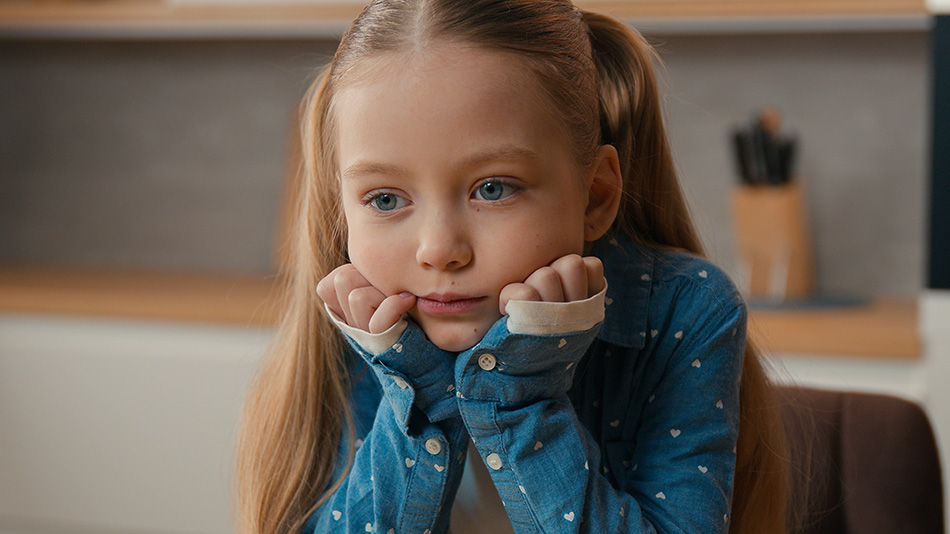Back to School Anxiety by Dr. Jill Haltigan
While the start of a new school year is often a welcome respite for parents, it can bring mixed emotions for our children. Many kids express a combination of both excitement and nervous anticipation; enthusiasm at seeing old friends and getting back to extracurricular activities they love, but also some butterflies at the prospect of new teachers and new classes. Some kids, however, have more than just first day jitters. This can be especially true for those entering a transitional year – kindergarten, freshman year of high school – or starting at a new school after a move. Rates of anxiety disorders in children have unfortunately been increasing over the past couple of decades, even prior to the pandemic. The upheaval our kids faced with school closures and limited extracurriculars the last few years certainly had a very deleterious effect on their mental health, as well. Despite these troubling statistics, there is help, and there is hope!
There are things that we as parents and other caretakers can do to help our kids who may be struggling. While anxiety disorders can develop at any time, it’s always wise to pay extra attention for potential signs in your children during periods we know are stressful, like the back to school transition. Most crucially is to recognize when an anxiety disorder may exist. All of us feel anxious at times, but it becomes a problem when that feeling becomes excessive, causes changes in our normal behavior or day to day functioning, or leads to physical symptoms.
Anxiety in children may not present as it does in adults. Kids usually cannot recognize that anxiety is underlying why they feel off; and if they do, it may be difficult for them to articulate. Children are often confused as to what is happening to them, and may become more withdrawn, or irritable as a result. They may develop new or worsening sleep issues, including trouble falling asleep, having nightmares and complaining of phantom physical problems like stomach aches or headaches. Some children may suddenly become clingy, not wanting to be separated from parents or caretakers even for activities that would otherwise bring them joy. Other kids may engage in nervous ticks, like fidgeting, chewing on a shirt collar, or twirling their hair for example. Teachers are our partners in noticing if something might be of concern as well. They may notice a child is unable to focus during their lessons, or spends an inappropriate amount of time double or triple checking their work.
Anxiety can hide both within the perfect student who is overly concerned with getting perfect grades, and within the disruptive class clown who tries to distract away the unpleasant thoughts and worries. It’s important to consider anxiety before assuming a child has another medical issue, like attention deficit disorder, depression, or obsessive compulsive disorder. Teachers and school specialists and administrators can help elucidate whether a learning disability, or bullying, or sometimes even substance use, may be a contributing factor, as well. In short, anytime a child’s behavior changes it is a good time to start asking more questions about potential underlying causes.
At the root of all anxiety is an underlying fear, even if that fear is not specific or realistic. It’s important not to dismiss this emotion or suggest that it’s silly to worry about something. Anxiety does not have an on and off switch that kids (or adults!) can activate. Rather, validate your child’s feelings. It is scary to go to a new school or meet a new teacher. It is hard to develop new routines and learn new subjects. Remind your child of a time he or she did something new and how well it worked out. Express confidence in them and their ability to figure it out. Reassure your child that you will be there to help and support them as needed. Another helpful tool is easing your child back into a school year routine as summer winds down. For older kids who have been staying up late and sleeping in, moving bedtime up even just 5-10 minutes a night can make a huge difference after a week or two. Younger children may benefit from starting to pick out their outfits and setting out their toothbrush and toothpaste the night before to help the morning routine run more smoothly. Taking advantage of opportunities to meet new teachers or tour new buildings before the school year starts can also help ease minds worried about not knowing a familiar face or where to go. Expect your children to be more tired the first few weeks as they adjust to all the changes, as well. As the start of the new school year coincides with the last few precious weeks of summer, it can be tempting to cram in a bunch of fun activities at night, but having a bit of down time for your child to simply “chill out” might actually be best for everyone.
Sleep is critically important for children in general, but it’s also a critical antidote to anxiety. Take time as the school year starts to help your child establish good sleep hygiene. Set a bedtime, and insist on at least 30 minutes of screen free wind down time prior. Talk to your child’s doctor right away if you notice any persistent sleep issues as that can potentially lead to other problems if not treated. Also, physical activity helps manage anxiety and promotes good sleep. Win win! If your child is not involved in organized sports, encourage him or her to take even just 15-20 minutes outside every day to engage in comfortable movement. Consider joining them for a simple walk some evenings, utilizing that time to ask how they’re feeling about school so far. Or just spend a few minutes connecting distraction-free at home. Kids aren’t usually looking for answers or solutions from their trusted adults, they simply need to know they’re being heard.
If you do recognize signs of anxiety in your child as the new school year approaches, and things do not improve as expected once the year gets underway, it’s time to seek professional help. Your child’s pediatrician or family doctor is the best place to start. While they can refer you to a trusted therapist or psychiatrist, they can also diagnose various anxiety disorders and discuss treatments like including talk therapy, cognitive behavioral therapy, and medication. If your child’s school has a therapist or counselor, they may also help develop a plan for specific support opportunities available during the school day. Some students will benefit from having a list of strategies that can help when feeling overly anxious; a list that can even be shared with his or her teachers to help build their support network. These options could include excusing a student to the hallway as needed to take some deep breaths in private, or a teacher being sure to check in with a child during a difficult subject if they are apt to be too nervous to raise their hand for help. As anxiety disorders are becoming more common, schools are becoming better equipped to handle them. Many schools are implementing mindfulness training for staff and students, and even have sensory rooms to help restore a sense of calm.
Again, anxiety disorders do not only appear at the start of the school year, but since this is a time of great stress for many children, it’s worth discussing. Check in with your child about how they are feeling and how you can help – even if they seem to be handling things just fine. Reminding your children early and often that you are always there to support them, and creating regular opportunities for interaction without distraction, can reinforce this message and engender an open line of communication so that when worries do arise, they can be openly discussed and worked through together.
A burden shared is always a burden lessened. I wish you all good health and a great school year! ❦
 About the Author
About the Author
Jill Haltigan, MD, is a family physician working with Mercy Health in Youngstown, OH. In addition to seeing patients of all ages in the outpatient setting, she also serves as a community preceptor for the family St. Elizabeth Hospital Boardman Family Medicine Residency program.
Outside of work she is as avid sports fan, and enjoys reading and cooking. Mostly, she loves to spend time at home with her husband, two young sons, and foster daughter.
